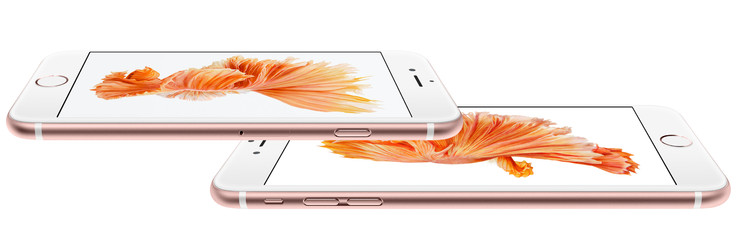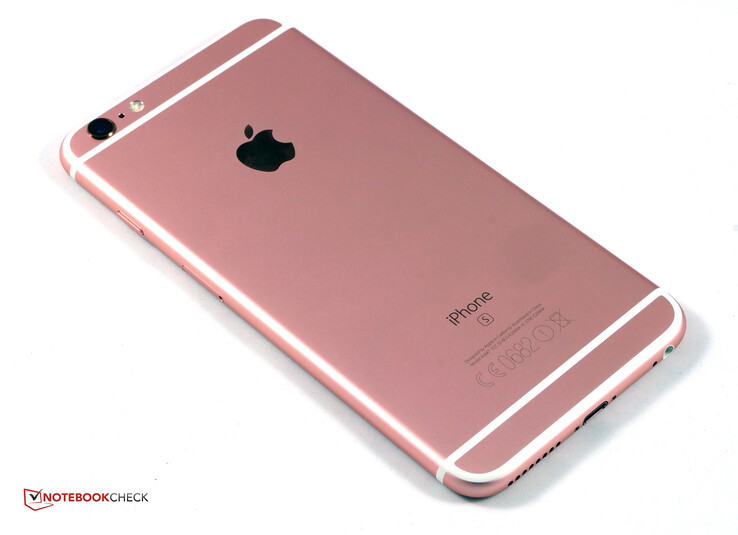Apple iPhone 6S and iPhone 6S Plus First Impressions

For the original German preview, see here.
The new iPhones from Apple with the number 6S and 6S Plus are the best iPhones that Apple has ever created – it seems that you hear this sentence 50 times at every keynote. However, this is not surprising since we would not need a new device if the latest generation were not better. So why are the iPhone 6S and 6S Plus the best of their kind? Like every new generation, Apple uses a new and more powerful SoC. The CPU of the 64-bit chip A9 is supposed to be 70% faster than the predecessor, and the GPU is supposed to be 90% faster. You now also get twice the amount of memory at 2 GB. Still, the performance is not really a problem for the older device even after one year. The new input method, 3D Touch, is significantly more exciting. As well as gestures, the touchscreen now recognizes applied pressure. This is already familiar from the TrackPad with Force Touch, but 3D Touch, can also differentiate between light and harder touches, and launch corresponding actions or open menus.
Apple also claims that they have improved the cameras significantly. At least the technical specifications suggest a clear step forwards. The iSight main camera now uses a 12 MP sensor that can also record videos in 4K. A 5 MP sensor is on the front, which means that Apple no longer ignores the selfie trend and also uses the display as a flash. However, according to Apple the greatest new feature is Live Photo. The camera takes a small video as well as the actual picture, which starts 1.5 seconds before you take the shot and ends 1.5 seconds after. This is supposed to make interactive pictures. We are already familiar with a similar feature from the Lumia 930.
This might actually be necessary when you consider the increased prices. The storage capacities have not changed compared to the iPhone 6 at 16, 64 and 128 GB, but this does not stop Apple from charging a steep price for the 6S. The entry-level model of the 6S now retails for 739 Euros (~$827) and goes all the way up to 949 Euros (~$1062). The prices of the 6S Plus are between 849 and 1069 Euros (~$950 and ~$1197). This means the new devices are 40 to 70 Euros (~$45 to ~$78) more expensive than the predecessors. The Rose Gold color is a new addition, but Space Gray, Silver and Gold are still available.
We want to use this preview to have a quick look at the performance as well as 3D Touch and take some pictures with the new cameras. Apple also claims to have improved the case in terms of stability and scratch-resistance, so we will cover this as well. Finally, we can make initial statements about the power consumption and the expected battery runtimes.
First Impressions
The new iPhones are slightly thicker, wider and longer than before. However, the changes are hardly noticeable, only the heavier weight is immediately perceptible in a direct comparison. iPhone 6S and 6S Plus are now 14 and 20 grams (~0.5 and 0.7 oz), respectively, heavier than their predecessors. This means that the 5.5-inch Plus in particular is now quite heavy; a similarly sized LG G4s is almost 40 grams (~1.4 oz) lighter. The additional weight is mainly caused by the necessary technology and the realization of 3D Touch. This includes capacitive sensors in the backlight layer and the so-called Taptic Engine, which creates a tactile feedback for the new touch functions Peek and Pop.
Apple now uses 7000 series aluminum for the unibody construction, which is also supposed to be used in the aerospace sector. It is ultimately an aluminum alloy with zinc as a main alloy element. The aerospace sector is just one of many fields of application for 7000 series aluminum. Sport devices, bicycles and airplanes in particular, use this alloy. It is characterized by a very high strength of 220 up to 700 Nm/mm² depending on the composition of the alloy. The Ion-X-glass at the front is also supposed to be much more robust than before. Apple even claims it is the strongest glass in the smartphone sector. The development was necessary when we look at our 12-month old iPhone 6. There are numerous scratches on the display and we can see clear signs of wear at the back as well. We still have an iPhone 5 in our editorial office, which is three years old and looks almost new in comparison. By the way, a quick bending test was not an issue for the iPhone 6S Plus. If you bend the new iPhone, then it is on purpose. However, apart from the materials, the weight and the dimensions, there are no changes. The design of the new generation is identical to the predecessors.
Apple has also updated the communication modules. The 4G module now supports LTE Advanced Cat. 6 with 23 bands and a theoretical transfer rate of up to 300 Mbps (downstream). The Wi-Fi module is also slightly improved and now reaches up to 866 Mbps thanks to the MIMO technology. Bluetooth is fully up to date with version 4.2, and NFC is still not usable for third-party apps. The fingerprint scanner Touch ID is also supposed to be faster.
Handling
The main focus of the optimized control concept of the new iPhones is 3D Touch. The touchscreen does not only recognize taps and swipe gestures, it now also recognizes pressure – in different intensities. Apple calls the corresponding actions Peek and Pop. Compatible apps also show some kind of context menu on the home screen. Apple calls this Quick Actions. You definitely have to get used to the new concept, but it does not take very long. We internalized the Quick Actions after a couple of hours, but we have to use the smartphone for a longer period for Peek and Pop – especially since there are even more new functions like pressing and swiping from the side, which can be used to switch between opened apps.
Cameras
Apple has put a lot of work into the cameras and delivered a long overdue update, which finally includes a higher resolution and Ultra HD video. The front sensor now has 5 MP (instead of just 1.2 MP). The main camera gets four more MP to a total of 12 MP. Unfortunately, the optical image stabilizer is still reserved for the larger iPhone 6S Plus.
We took some sample pictures right away and so far, they leave a very good impression. Daylight pictures in particular, are razor-sharp and have great colors. The sensor of the iPhones has some issues with backlight and the automatic HDR feature cannot compensate for it as well as the LG G4 or the Samsung Galaxy S6 (Edge). We would like to see a higher dynamic range.
The quality of close-ups with the iPhone 6S (Plus) are good. You can see some blur towards the edges, but this is not unusual for a smartphone camera.
We took the low-light picture under subdued lighting. You can already see some frayed edges and isolated fragments, but the noise is very limited. Once again, the first impression is decent, but we can already say that the new iPhone cameras will not be able to keep up with the high-end models from the competition.
Display
The display is one of the few aspects where the new iPhones do not look any different from their predecessors. This is also the reason that Phil Schiller hardly mentioned it during the keynote, and why we only have a brief look at it in the preview as well. The 4.7-inch display of the iPhone 6S still has 1334x750 pixels (326 ppi), while the 5.5-inch iPhone 6S Plus still uses FHD (1920x1080 pixels). The measurement results of the current models are close to their predecessors, but we cannot yet confirm that Apple uses identical displays. There are some deviations. The iPhone 6S Plus, for example, is around 10% brighter than its direct predecessor with a maximum of 583 cd/m². Black value and contrast are improved as well. However, the new iPhones are still not on par with the top smartphones from Samsung with Super AMOLED screens. Still, the screens of the new iPhones are undoubtedly among the best on the market.
Nothing has really changed in terms of picture quality. The deviations of the grayscale and the colors are not usually visible to the human eye. The subjective picture quality is also very convincing, only the black areas appear a bit too pale at high luminance settings.
Brightness Distribution iPhone 6S
| |||||||||||||||||||||||||
Brightness Distribution: 87 %
Center on Battery: 552 cd/m²
Contrast: 1415:1 (Black: 0.39 cd/m²)
ΔE ColorChecker Calman: 3.4 | ∀{0.5-29.43 Ø4.78}
ΔE Greyscale Calman: 4.16 | ∀{0.09-98 Ø5}
95.93% sRGB (Argyll 1.6.3 3D)
62.18% AdobeRGB 1998 (Argyll 1.6.3 3D)
Gamma: 2.21
CCT: 7288 K
Brightness Distribution iPhone 6S Plus
| |||||||||||||||||||||||||
Brightness Distribution: 91 %
Center on Battery: 583 cd/m²
Contrast: 1267:1 (Black: 0.46 cd/m²)
ΔE ColorChecker Calman: 3.55 | ∀{0.5-29.43 Ø4.78}
ΔE Greyscale Calman: 3.88 | ∀{0.09-98 Ø5}
92.8% sRGB (Argyll 1.6.3 3D)
59.05% AdobeRGB 1998 (Argyll 1.6.3 3D)
Gamma: 2.2
CCT: 7280 K
| Apple iPhone 6S A9 / PowerVR GT7600, A9, Apple AP0064K (iPhone NVMe) | Apple iPhone 6 PowerVR GX6450, A8, 128 GB eMMC Flash | OnePlus 2 Adreno 430, 810 MSM8994, 64 GB eMMC Flash | LG G4 Adreno 418, 808 MSM8992, 32 GB eMMC Flash | Samsung Galaxy S6 Edge Mali-T760 MP8, Exynos 7420, 32 GB UFS 2.0 Flash | Huawei P8 Mali-T628 MP4, Kirin 930, 16 GB eMMC Flash | Sony Xperia Z3+ Adreno 430, 810 MSM8994, 32 GB eMMC Flash | |
|---|---|---|---|---|---|---|---|
| Screen | -18% | -3% | -17% | 9% | -4% | -37% | |
| Brightness middle (cd/m²) | 552 | 520 -6% | 451 -18% | 566 3% | 343 -38% | 453 -18% | 605 10% |
| Brightness (cd/m²) | 549 | 511 -7% | 446 -19% | 536 -2% | 338 -38% | 439 -20% | 601 9% |
| Brightness Distribution (%) | 87 | 88 1% | 90 3% | 90 3% | 94 8% | 91 5% | 92 6% |
| Black Level * (cd/m²) | 0.39 | 0.61 -56% | 0.3 23% | 0.47 -21% | 0.28 28% | 0.53 -36% | |
| Contrast (:1) | 1415 | 852 -40% | 1503 6% | 1204 -15% | 1618 14% | 1142 -19% | |
| Colorchecker dE 2000 * | 3.4 | 3.92 -15% | 3.84 -13% | 6.17 -81% | 2.2 35% | 4.7 -38% | 9.24 -172% |
| Greyscale dE 2000 * | 4.16 | 4.33 -4% | 3.97 5% | 6.26 -50% | 2.37 43% | 5.03 -21% | 10.01 -141% |
| Gamma | 2.21 100% | 2.46 89% | 2.46 89% | 2.48 89% | 2.41 91% | 2.27 97% | 2.22 99% |
| CCT | 7288 89% | 7384 88% | 7283 89% | 8171 80% | 6425 101% | 7439 87% | 10343 63% |
| Color Space (Percent of AdobeRGB 1998) (%) | 62.18 | 58.07 -7% | 65.48 5% | 87.77 41% | 72.04 16% | 65.65 6% | |
| Color Space (Percent of sRGB) (%) | 95.93 | 90.14 -6% | 98.63 3% | 97.1 1% |
* ... smaller is better
Performance
Both the iPhone 6S as well as its larger sibling iPhone 6S Plus use the new Apple A9 SoC. Once again, it is a 64-bit dual-core processor, which is supported by 2 GB of RAM this time. This is actually twice as much as before. Apple uses LPDDR4-RAM. According to Apple, the performance of the new CPU is up to 70% higher than the iPhone 6 .
The performance of the graphics unit is supposed to be 90% faster. The GPU is currently provided by Imagination, and they certainly provide their fastest chip for Apple’s devices. Even though there are no specifics yet, it is very likely that it is a GPU from the PowerVR Series7XT family, probably the fastest chip GT7600.
The performance in the initial benchmarks is impressive and easily beats the competition. The CPU is almost 70% faster than the Galaxy S6 (Edge) in Geekbench 3, but the dual-core falls behind devices with the Exynos 7420 and Snapdragon 810 when all cores can be utilized.
The SoC is not that important in the system benchmarks like AnTuTu v5, where the Samsung flagship benefits particularly from its fast storage. However, iPhone 6S and iPhone 6S Plus manage very good results. It will be a tough task to beat the graphics performance of the new iPhones, where the advantage over the competition varies between 14 (Adreno 430) and 78% (ARM Mali-T760 MP8).
We will evaluate the strong performance of the new S models in more detail in our in-depth reviews. We will have a closer look at the stability of the performance in particular.
| Geekbench 3 | |
| 64 Bit Single-Core Score (sort by value) | |
| Apple iPhone 6S | |
| Samsung Galaxy S6 Edge | |
| LG G4 | |
| OnePlus 2 | |
| HTC One M9 | |
| Sony Xperia Z4 Tablet | |
| 64 Bit Multi-Core Score (sort by value) | |
| Apple iPhone 6S | |
| Samsung Galaxy S6 Edge | |
| LG G4 | |
| OnePlus 2 | |
| HTC One M9 | |
| Sony Xperia Z4 Tablet | |
| AnTuTu v5 - Total Score (sort by value) | |
| Apple iPhone 6S | |
| Apple iPhone 6 Plus | |
| Apple iPhone 6 | |
| Samsung Galaxy S6 Edge | |
| LG G4 | |
| OnePlus 2 | |
| HTC One M9 | |
| NVIDIA Shield Tablet LTE P1761 | |
| Sony Xperia Z4 Tablet | |
| 3DMark | |
| 1280x720 offscreen Ice Storm Unlimited Score (sort by value) | |
| Apple iPhone 6S | |
| Apple iPhone 6 Plus | |
| Apple iPhone 6 | |
| Samsung Galaxy S6 Edge | |
| LG G4 | |
| OnePlus 2 | |
| HTC One M9 | |
| Sony Xperia Z4 Tablet | |
| 1280x720 offscreen Ice Storm Unlimited Graphics Score (sort by value) | |
| Apple iPhone 6S | |
| Apple iPhone 6 Plus | |
| Apple iPhone 6 | |
| Samsung Galaxy S6 Edge | |
| LG G4 | |
| OnePlus 2 | |
| HTC One M9 | |
| Sony Xperia Z4 Tablet | |
| 1280x720 offscreen Ice Storm Unlimited Physics (sort by value) | |
| Apple iPhone 6S | |
| Apple iPhone 6 Plus | |
| Apple iPhone 6 | |
| Samsung Galaxy S6 Edge | |
| LG G4 | |
| OnePlus 2 | |
| HTC One M9 | |
| Sony Xperia Z4 Tablet | |
| Basemark ES 3.1 / Metal - offscreen Overall Score (sort by value) | |
| Apple iPhone 6S | |
| OnePlus 2 | |
| HTC One M9 | |
| NVIDIA Shield Tablet LTE P1761 | |
| Sony Xperia Z4 Tablet | |
| Octane V2 - Total Score (sort by value) | |
| Apple iPhone 6S | |
| Apple iPhone 6 Plus | |
| Apple iPhone 6 | |
| Samsung Galaxy S6 Edge | |
| LG G4 | |
| OnePlus 2 | |
| HTC One M9 | |
| Sony Xperia Z4 Tablet | |
| JetStream 1.1 - Total Score (sort by value) | |
| Apple iPhone 6S | |
| Samsung Galaxy S6 Edge | |
| LG G4 | |
| OnePlus 2 | |
| HTC One M9 | |
| WebXPRT 2015 - Overall (sort by value) | |
| Apple iPhone 6S | |
| LG G4 | |
| OnePlus 2 | |
| HTC One M9 | |
| NVIDIA Shield Tablet LTE P1761 | |
| Sony Xperia Z4 Tablet | |
Energy & Battery Runtime
3D Touch or the new Taptic Engine, respectively, needs space – which affect the battery capacity. While the battery of the iPhone 6 still provided 6.91 Wh, the latest generation only gets a 6.55 Wh module. This is combined with a significant performance increase, slightly brighter display and new control methods. Apple still promises a runtime similar to the predecessor. Our initial measurements of the power consumption are just a small indicator of the runtimes, but it seems that the S models are slightly more frugal than the older models. We are eager to see the results.
Preliminary Verdict
The S models from Apple are usually just a gentle update of the iPhones in combination with a significant performance increase. However, the Americans have put more effort into this generation compared to previous S models. 3D Touch is not a revolutionary control concept – notebooks have used this for a while – but the handling of the smartphones does change quite a bit, especially since Apple includes a number of useful features. Apple has also improved the cameras significantly. The additional pixels of the main camera are more noticeable in the specifications than in practice, but 4K videos and a decent selfie camera were long overdue. The use of more robust materials certainly does not hurt, either. The predecessors were at least pretty prone to micro scratches.
The new generation of iPhones is once again the most powerful, what a surprise. However, what the A9 chip is actually capable of is really impressive. We have to wait and see if the good initial impression is confirmed in the in-depth review. We will also see whether the A9 chip can maintain its performance under load or if it tends to throttle.
























